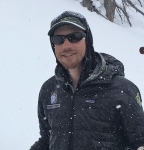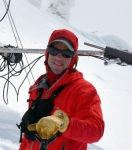Blog List


Happy New Year.
I want to take this time to highlight a new things happening at the GNFAC, both with personnel and on our website.
New Forecaster

After the two snowmobiler avalanche fatalities on Reas Peak in the Centennial Range in January 2018 we created a webpage so riders could get good, relevant information regarding snowpack and avalanches.

Published in the Winter 2018 issue of Outside Bozeman

On September 16th winter arrived with a foot of snow in the mountains. On the 17th a skier triggered the first avalanche of the season. On the 19th, after continued snowfall, Alex issued the first avalanche information bulletin, the earliest in 28 years of operation.

A large, 8-10’ deep avalanche on Woody Ridge outside of Cooke City yesterday (1/30) surprised me and is making me reexamine what I know – and what I don’t know – about the snowpack in the Cooke City area. I'm giving this zone a lot of thought because, depending on what the next storms do, we may be at the start of a significant avalanche cycle.

Introducing the GNFAC’s New Website!
New look. New feel.
Greetings from the GNFAC.
We just launched our new website today and hope you find it easier to navigate and use. There are two major changes:
1. The site is mobile friendly.

We are wrapping up our 27th year of operation after issuing 138 avalanche advisories. Less snow in the northern mountains (87% of average) contrasted with the southern ranges where up to 117% of average snowpack was measured.

The Pit Stop - Dig and Communicate
Snow ties the backcountry community together, sometimes it ties us to avalanches. Taking the time to dig a snowpit and assess snow stability provides valuable information and generates conversation between group members. Good communication leads to better decision making in avalanche terrain.

When venturing into the backcountry, answering these two questions is essential when assessing a slope to ride:
Is the terrain capable of producing an avalanche?
-and-
Can the snow slide?
Avalanches happen when four ingredients are present: a slab, a weak layer, a trigger and a slope steep enough to slide. A key problem when assessing slope angle is that most slopes have varying degrees of steepness. It is critical for riders to assess slope angle frequently.

Greetings:
The Gallatin National Forest Avalanche Center just wrapped up 26 years of operation. We started the season with the threat of a dry El Nino winter which never materialized and finished with a snowpack measuring close to 100% average. March got almost as much snow as January and February combined.

by Alex Marienthal
Spring is here with longer days and a more predictable snowpack to facilitate objectives that are steeper and farther. These objectives are possible while maintaining a personally acceptable level of avalanche risk. However, these objectives can mean more exposure to other hazards like exposed terrain and prolonged rescue, which increases the consequences of relatively small accidents. The snowpack structure is changing from cold, dry layers to warm, wet and icy layers. This transition creates a fresh mix of avalanche problems.

Digging a Snowpit Matters
An online article posted October 29, 2015 for BackcountryMagazine.com on snowpits, avalanche character, and the difficulties and risks of traveling in various types of snow, is a welcome early season jump-start to get us thinking about snow and avalanches. Every snow climate is different and every professional forecaster looks at the snowpack through his and her own forecasting lens, but we are all trying to increase the understanding of avalanches in order have fun and stay alive.

Chris Lundy, owner of Sawtooth Mountain Guides, wrote a great article in Backcountry Magazine about digging pits. He opens the story with a personal account of triggering an avalanche. I was with him that day. We triggered the slide up Fisher Creek outside Cooke City on March 10, 2002.

On February 25, 2015 the Panjshir Valley in Afghanistan had an avalanche cycle that killed at least 168 people. The reports at the time claimed over 200 dead making international headlines. A few weeks ago I visited the valley and wrote this "Official" report. I wrote it for Hameed Habibi who runs the Afghanistan Avalanche Control Team at the Salang Tunnel.
The fatality numbers (168) are the best we could gather based on interviews. If anything, they might be slightly understated.

April 16, 2015
Greetings:
What a strange year it has been. We started strong with many storms and early season snow, followed by spring weather in February and March and then one of the biggest snowfalls of the season yesterday. Go figure. Although skiing and snowmobiling conditions were bipolar, the snowpack was generally stable with more days of “Low” avalanche danger than any of us can remember.

Spring skiing can be some of the best of the season. Good snow coverage, warmer weather and more predictable snow stability (at times) can lead to unmatched conditions. While spring skiing can be the best, it can also hold avalanche hazards not encountered during the colder parts of winter.
As snowpack and weather transition into a warmer and wetter spring pattern, there are a number of avalanche variables to pay attention to.

Five Easy Steps to Safe Backcountry Riding
By: Eric Knoff
Gallatin National Forest Avalanche Center

The snowpack changes from year to year, even day to day but, the terrain on which snow falls remains constant. Understanding and recognizing avalanche terrain are critical tools for safe decision making in the backcountry.
During stable snow conditions, riding in avalanche terrain is safe and acceptable. When snow conditions are unstable, avoiding steep slopes and avalanche run out zones is key to avoiding avalanches.

Published in the April 2015 issue of The Avalanche Review.
Lynne Wolfe, editor of TAR, asked me to jot a few thoughts down on how we manage surface hoar once it is buried. This is the email I sent back to her.
